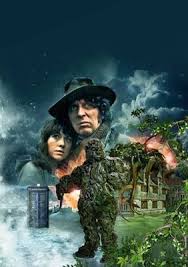
Two alien seed pods are found buried in the Antarctic permafrost and the Doctor, brought in by helicopter, realizes they are from a Krynoid, a form of plant life that infests and transforms animal life. They have been buried there since the late Pleistocene—20,000 years ago. One of the pods infects a scientist, but the Krynoid is destroyed by Scorby (John Challis) and Keeler (Mark Jones), who have stolen the other pod for their boss, eccentric collector Harrison Chase (Tony Beckley). He believes the world belongs to the plants and all animals, including humans, are only parasites. The bad guys set a bomb to blow up the entire installation and everything living or dead inside, but the Doctor and Sarah Jane escape and survive. They are brought to England, where it doesn’t take the Doctor long to figure out who’s behind it all.
At his mansion in England, played by Athelhampton House in Dorset, Chase is ready to open the pod under controlled conditions while a human host is held nearby. The proposed host is Sarah Jane Smith. The Doctor rescues her, but Keeler is infected. Chase feeds him raw meat to accelerate his transformation. Chase talking to his plants is chilling. The creature escapes and rampages through the house, growing rapidly until, at the end, it towers over the building like Ray Harryhausen’s giant octopus climbing the Golden Gate Bridge in It Came from Beneath the Sea. Chase decides to turn the Doctor into compost by feeding him into a pulveriser. The Doctor escapes, but Chase falls into the machine. UNIT and the RAF come in and bomb the house before the Krynoid can spread its pods throughout the Earth.
The influences on this story are obvious—The Thing from Another World, the Quatermass Experiment (again), Day of the Triffids—but the whole story seems like an episode of the British Avengers show, with the Doctor as Steed and Sarah Jane as Mrs. Peel. The Doctor even has a gun. But the dialogue is inventive, and it possesses a dark atmosphere and a memorable villain, and it is well-liked. Even the Krynoids are fairly convincing. Peter Brachaki (1926-1980) designed the TARDIS for the first Doctor Who episode in 1963, and except for some minor changes and a general weathering down, it remained the Brachaki TARDIS until the last scene of this story was filmed, whereupon it collapsed with Tom Baker and Elizabeth Sladen inside, and had to be rebuilt. From then on, it began to change, eventually serving up a new and startling interior with each new Doctor. The TARDIS interior is to Doctor Who as the Nautilus was to Captain Nemo.
Part 1
Part 2
Part 3
Part 4
Part 5
Part 6
